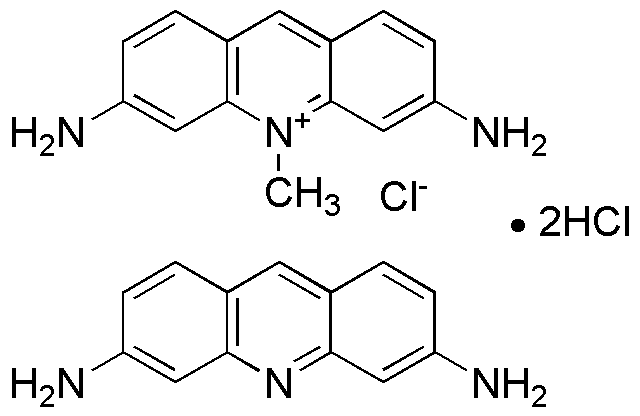Acriflavine hydrochloride is widely utilized in research focused on:
- Antimicrobial Applications: This compound is effective against a range of bacteria and fungi, making it valuable in developing antiseptics and disinfectants for medical use.
- Cell Staining: In histology and microbiology, acriflavine is used as a fluorescent stain, aiding researchers in visualizing cellular structures under a microscope.
- Genetic Research: It has been employed in studies of DNA and RNA due to its ability to intercalate with nucleic acids, helping scientists understand genetic mechanisms.
- Veterinary Medicine: Acriflavine hydrochloride is used in aquaculture to treat fish diseases, providing a safe and effective solution for maintaining healthy aquatic environments.
- Antiparasitic Treatments: This compound shows promise in treating certain parasitic infections, offering an alternative to traditional therapies and expanding treatment options for patients.
General Information
Properties
Safety and Regulations
Applications
Acriflavine hydrochloride is widely utilized in research focused on:
- Antimicrobial Applications: This compound is effective against a range of bacteria and fungi, making it valuable in developing antiseptics and disinfectants for medical use.
- Cell Staining: In histology and microbiology, acriflavine is used as a fluorescent stain, aiding researchers in visualizing cellular structures under a microscope.
- Genetic Research: It has been employed in studies of DNA and RNA due to its ability to intercalate with nucleic acids, helping scientists understand genetic mechanisms.
- Veterinary Medicine: Acriflavine hydrochloride is used in aquaculture to treat fish diseases, providing a safe and effective solution for maintaining healthy aquatic environments.
- Antiparasitic Treatments: This compound shows promise in treating certain parasitic infections, offering an alternative to traditional therapies and expanding treatment options for patients.
Documents
Safety Data Sheets (SDS)
The SDS provides comprehensive safety information on handling, storage, and disposal of the product.
Product Specification (PS)
The PS provides a comprehensive breakdown of the product’s properties, including chemical composition, physical state, purity, and storage requirements. It also details acceptable quality ranges and the product's intended applications.
Certificates of Analysis (COA)
Search for Certificates of Analysis (COA) by entering the products Lot Number. Lot and Batch Numbers can be found on a product’s label following the words ‘Lot’ or ‘Batch’.
*Catalog Number
*Lot Number
Certificates Of Origin (COO)
This COO confirms the country where the product was manufactured, and also details the materials and components used in it and whether it is derived from natural, synthetic, or other specific sources. This certificate may be required for customs, trade, and regulatory compliance.
*Catalog Number
*Lot Number
Safety Data Sheets (SDS)
The SDS provides comprehensive safety information on handling, storage, and disposal of the product.
DownloadProduct Specification (PS)
The PS provides a comprehensive breakdown of the product’s properties, including chemical composition, physical state, purity, and storage requirements. It also details acceptable quality ranges and the product's intended applications.
DownloadCertificates of Analysis (COA)
Search for Certificates of Analysis (COA) by entering the products Lot Number. Lot and Batch Numbers can be found on a product’s label following the words ‘Lot’ or ‘Batch’.
*Catalog Number
*Lot Number
Certificates Of Origin (COO)
This COO confirms the country where the product was manufactured, and also details the materials and components used in it and whether it is derived from natural, synthetic, or other specific sources. This certificate may be required for customs, trade, and regulatory compliance.


